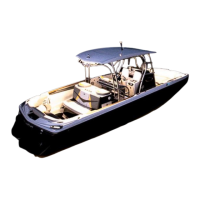Registration, Numbering and Documentation
Although it might not be immediately obvious as to how this relates to boating safety, in fact it can be critical in emergencies. All undocumented
vessels equipped with propulsion machinery must be registered in the state of principal use. A certicate of number will be issued upon registering
the vehicle. These numbers must be displayed on your vessel. The owner/operator of the vessel must carry a valid certicate of number whenever
the vessel is in use. When moving to a new state of principal use, the certicate is valid for 60 days. Check with your state boating authority for reg-
istration requirements.
Numbers must be painted or permanently attached to each side of the forward half of the vessel.
The validation stickers must be axed within six inches of the registration number. With the excep-
tion of the vessel fee decal, no other letters or numbers may be displayed nearby. Lettering must
be in plain, vertical block characters of not less than three (3) inches in height. Spaces or hyphens
between letter and number groupings must be equal to the width of a letter other than “i” or a
number other than “1.”
The owner of a vessel must notify the agency which issued the certicate of number within fteen (15)
days if the vessel is transferred, destroyed, abandoned, lost, stolen or recovered, or if the certicate of
number is lost, destroyed or the owner’s address changed. If the certicate of number becomes invalid for
any reason, it must be surrendered in the manner prescribed to the issuing authority within 15 days.
Operator’s
License
Some states are implementing opera-
tor’s license requirements. These require-
ments vary widely. Whether operating a
boat locally or in a remote location, op-
erators should verify with state and local
authorities regarding whether a license
or training is required. This should be
checked at least annually.
Recommended Equipment
The responsible boat owner will avoid potential problems on an outing by having additional
equipment on board. Normally, the decision regarding the appropriate equipment to take on
individual outings is dependent upon the body of water and the length of the trip. We suggest the
following equipment as a minimum (your MasterCraft dealer can also assist you with additional
recommendations):
• An anchor with at least 75 feet of line (in saltwater operation, particularly);
• A manual bailing device for removing water;
• A combination oar/boat hook;
• A day-and-night visual distress signal;
• A rst aid kit and manual;
• An airway breathing tube;
• A waterproof ashlight;
• A non-electric horn or whistle;
• A set of local navigational charts;
• Mooring lines and fenders;
• Extra engine oil;
• A tool kit; and
• A portable, battery-operated AM/FM radio or weather radio/scanner.
MasterCraft 2012 Owners Manual • Safety Knowledge • Page 1-6

